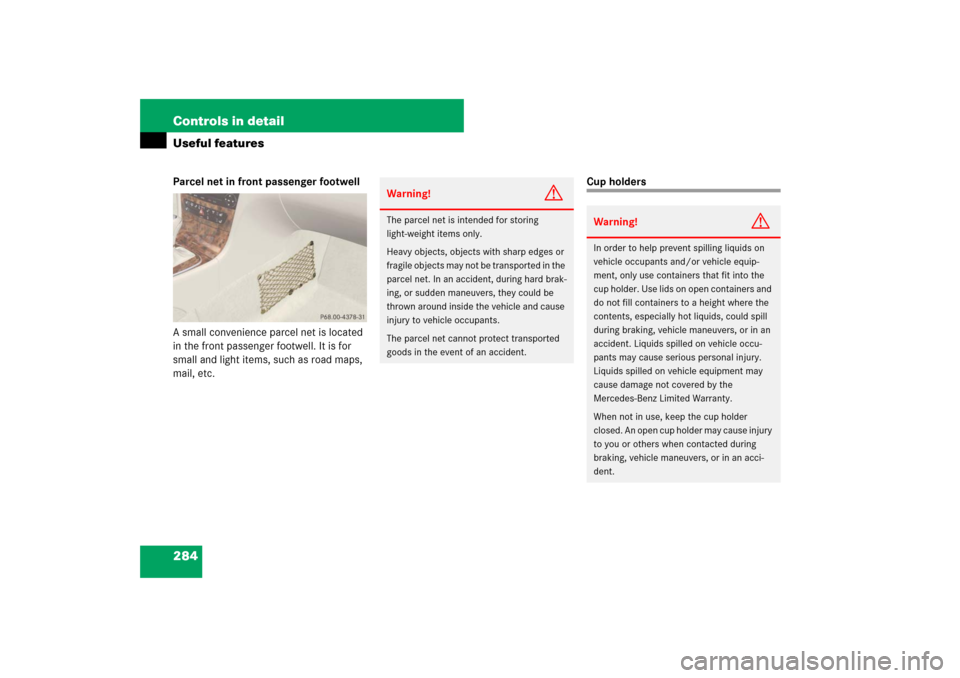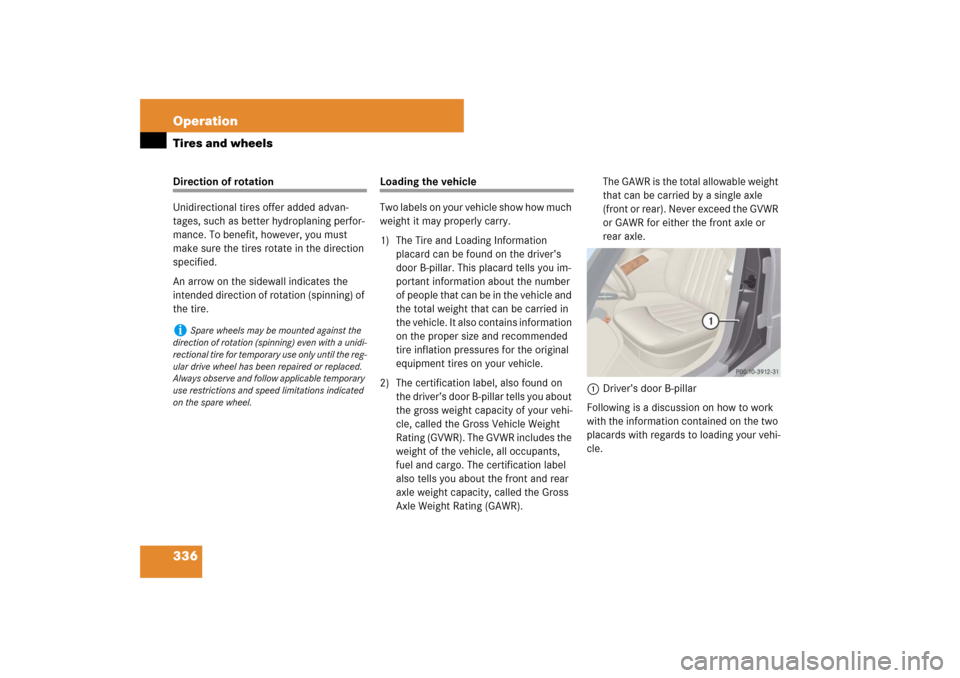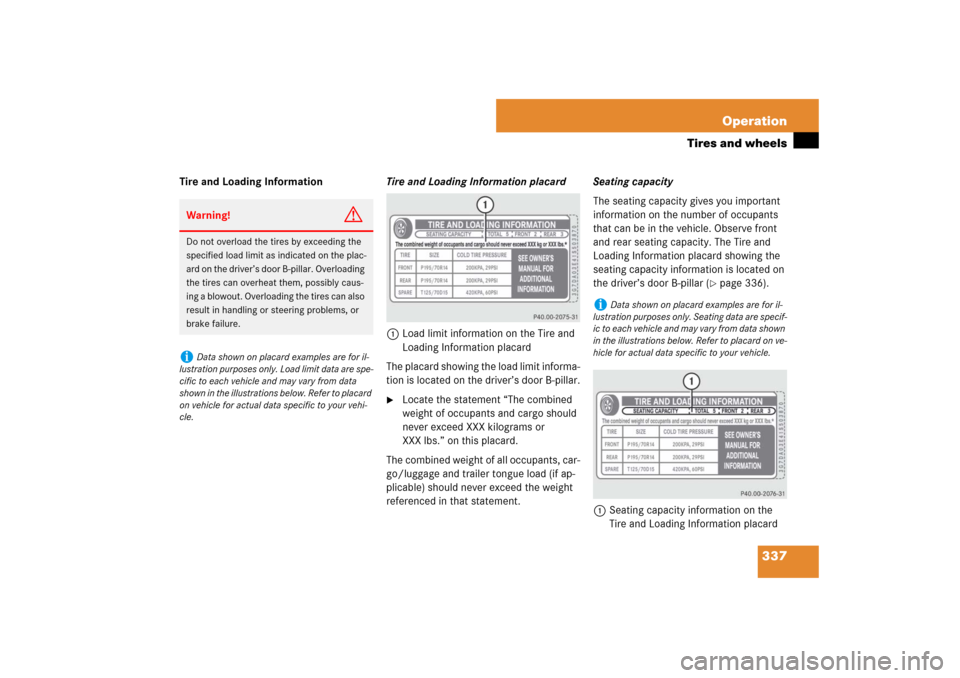Page 284 of 522
283 Controls in detail
Useful features
Storage compartment in the rear arm-
rest�
Press the handle upwards and fold the
rear armrest lid up.Ruffled storage bags
Ruffled storage bags are located on the
back of the front seats.
Warning!
G
USA only: Do not place objects with a com-
bined weight of more than 4.4 lb (2 kg) into
the ruffled storage bag. Otherwise, the
Occupant Classification System OCS
(�page 75) may not be able to properly
approximate the occupant weight category.
The ruffled storage bag is intended for stor-
ing light-weight items only.
Heavy objects, objects with sharp edges or
fragile objects may not be transported in the
ruffled storage bag. In an accident, during
hard braking, or sudden maneuvers, they
could be thrown around inside the vehicle
and cause injury to vehicle occupants.
The ruffled storage bag cannot protect
transported goods in the event of an acci-
dent.
Page 285 of 522

284 Controls in detailUseful featuresParcel net in front passenger footwell
A small convenience parcel net is located
in the front passenger footwell. It is for
small and light items, such as road maps,
mail, etc.
Cup holders
Warning!
G
The parcel net is intended for storing
light-weight items only.
Heavy objects, objects with sharp edges or
fragile objects may not be transported in the
parcel net. In an accident, during hard brak-
ing, or sudden maneuvers, they could be
thrown around inside the vehicle and cause
injury to vehicle occupants.
The parcel net cannot protect transported
goods in the event of an accident.
Warning!
G
In order to help prevent spilling liquids on
vehicle occupants and/or vehicle equip-
ment, only use containers that fit into the
cup holder. Use lids on open containers and
do not fill containers to a height where the
contents, especially hot liquids, could spill
during braking, vehicle maneuvers, or in an
accident. Liquids spilled on vehicle occu-
pants may cause serious personal injury.
Liquids spilled on vehicle equipment may
cause damage not covered by the
Mercedes-Benz Limited Warranty.
When not in use, keep the cup holder
closed. An open cup holder may cause injury
to you or others when contacted during
braking, vehicle maneuvers, or in an acci-
dent.
Page 287 of 522
286 Controls in detailUseful featuresRemoving cup holder
1Dual cup holder
2Locking pins�
Move both locking pins2 in direction
of arrows.
�
Take dual cup holder1 out upward.Reinstalling cup holder
3Locking pins
�
Insert cup holder.
�
Move both locking pins3 in direction
of arrows.Rear cup holder
�
Briefly press the front of the rear arm-
rest.
The cup holder extends automatically.
!
Make sure that the dual cup holder1 is
correctly positioned in the guides while you are
reinstalling it. Otherwise the cup holder can be
damaged.
!
Do not sit on or lean your body weight
against the armrest when it is folded down, as
you could otherwise damage it.
Page 337 of 522

336 OperationTires and wheelsDirection of rotation
Unidirectional tires offer added advan-
tages, such as better hydroplaning perfor-
mance. To benefit, however, you must
make sure the tires rotate in the direction
specified.
An arrow on the sidewall indicates the
intended direction of rotation (spinning) of
the tire.
Loading the vehicle
Two labels on your vehicle show how much
weight it may properly carry.
1) The Tire and Loading Information
placard can be found on the driver’s
door B-pillar. This placard tells you im-
portant information about the number
of people that can be in the vehicle and
the total weight that can be carried in
the vehicle. It also contains information
on the proper size and recommended
tire inflation pressures for the original
equipment tires on your vehicle.
2) The certification label, also found on
the driver’s door B-pillar tells you about
the gross weight capacity of your vehi-
cle, called the Gross Vehicle Weight
Rating (GVWR). The GVWR includes the
weight of the vehicle, all occupants,
fuel and cargo. The certification label
also tells you about the front and rear
axle weight capacity, called the Gross
Axle Weight Rating (GAWR).The GAWR is the total allowable weight
that can be carried by a single axle
(front or rear). Never exceed the GVWR
or GAWR for either the front axle or
rear axle.
1Driver’s door B-pillar
Following is a discussion on how to work
with the information contained on the two
placards with regards to loading your vehi-
cle.
i
Spare wheels may be mounted against the
direction of rotation (spinning) even with a unidi-
rectional tire for temporary use only until the reg-
ular drive wheel has been repaired or replaced.
Always observe and follow applicable temporary
use restrictions and speed limitations indicated
on the spare wheel.
Page 338 of 522

337 Operation
Tires and wheels
Tire and Loading InformationTire and Loading Information placard
1Load limit information on the Tire and
Loading Information placard
The placard showing the load limit informa-
tion is located on the driver’s door B-pillar.
�
Locate the statement “The combined
weight of occupants and cargo should
never exceed XXX kilograms or
XXX lbs.” on this placard.
The combined weight of all occupants, car-
go/luggage and trailer tongue load (if ap-
plicable) should never exceed the weight
referenced in that statement.Seating capacity
The seating capacity gives you important
information on the number of occupants
that can be in the vehicle. Observe front
and rear seating capacity. The Tire and
Loading Information placard showing the
seating capacity information is located on
the driver’s door B-pillar (
�page 336).
1Seating capacity information on the
Tire and Loading Information placard
Warning!
G
Do not overload the tires by exceeding the
specified load limit as indicated on the plac-
ard on the driver’s door B-pillar. Overloading
the tires can overheat them, possibly caus-
ing a blowout. Overloading the tires can also
result in handling or steering problems, or
brake failure.i
Data shown on placard examples are for il-
lustration purposes only. Load limit data are spe-
cific to each vehicle and may vary from data
shown in the illustrations below. Refer to placard
on vehicle for actual data specific to your vehi-
cle.
i
Data shown on placard examples are for il-
lustration purposes only. Seating data are specif-
ic to each vehicle and may vary from data shown
in the illustrations below. Refer to placard on ve-
hicle for actual data specific to your vehicle.
Page 339 of 522

338 OperationTires and wheelsSteps for determining correct load limit
The following steps have been developed
as required of all manufacturers under
Title 49, Code of U.S. Federal Regulations,
Part 575 pursuant to the “National Traffic
and Motor Vehicle Safety Act of 1966”.
Step 1�
Locate the statement “The combined
weight of occupants and cargo should
never exceed XXX kg or XXX lbs.” on
your vehicle’s placard.
Step 2
�
Determine the combined weight of the
driver and passengers that will be
riding in your vehicle.
Step 3
�
Subtract the combined weight of the
driver and passengers from XXX kilo-
grams or XXX lbs.Step 4
�
The resulting figure equals the avail-
able amount of cargo and luggage load
capacity. For example, if the “XXX”
amount equals 1400 lbs. and there will
be five 150 lbs. passengers in your
vehicle, the amount of available cargo
and luggage load capacity is 650 lbs.
(1400-750 (5 x 150) = 650 lbs.).
Step 5
�
Determine the combined weight of
luggage and cargo being loaded on the
vehicle. That weight may not safely
exceed the available cargo and luggage
load capacity calculated in step 4.Step 6 (if applicable)
�
If your vehicle will be towing a trailer,
load from your trailer will be trans-
ferred to your vehicle. Consult this
manual to determine how this reduces
the available cargo and luggage load
capacity of your vehicle (
�page 340).
The following table shows examples on
how to calculate total and cargo load
capacities with varying seating configura-
tions and number and size of occupants.
The following examples use a load limit
of 1500 lbs. This is for illustration
purposes only. Make sure you are using
the actual load limit for your vehicle stated
on the vehicle’s placard (
�page 337).
Page 340 of 522
339 Operation
Tires and wheels
The higher the weight of all occupants, the
less cargo and luggage load capacity is
available.
For more information, see “Trailer tongue
load” (
�page 340).
Example
Combined
weight limit
of occu-
pants and
cargo from
placard
Number of
occupants
(driver and
passengers)
Seating
configura-
tion
Occupants weight
Combined
weight of all
occupants
Available cargo/luggage and trailer
tongue weight (total load limit from
placard minus combined weight of
all occupants)
1
1500 lbs
5
front: 2
rear: 3
Occupant 1: 150 lbs
Occupant 2: 180 lbs
Occupant 3: 160 lbs
Occupant 4: 140 lbs
Occupant 5: 120 lbs
750 lbs
1500 lbs - 750 lbs = 750 lbs
2
1500 lbs
3
front: 1
rear: 2
Occupant 1: 200 lbs
Occupant 2: 190 lbs
Occupant 3: 150 lbs
540 lbs
1500 lbs - 540 lbs = 960 lbs
3
1500 lbs
1
front: 1
Occupant 1: 150 lbs
150 lbs
1500 lbs - 150 lbs = 1350 lbs
Page 341 of 522

340 OperationTires and wheelsCertification label
Even after careful determination of the
combined weight of all occupants, cargo
and the trailer tongue load (if applicable)
(�page 340) as to not exceed the permis-
sible load limit, you must make sure that
your vehicle never exceeds the Gross Vehi-
cle Weight Rating (GVWR) and the Gross
Axle Weight Rating (GAWR) for either the
front or rear axle. You can obtain the
GVWR and GAWR from the certification la-
bel. The certification label can be found on
the driver’s door B-pillar, see “Technical
data” (
�page 476).Gross Vehicle Weight Rating (GVWR): The
total weight of the vehicle, all occupants,
all cargo, and the trailer tongue load
(
�page 340) must never exceed the
GVWR.
Gross Axle Weight Rating (GAWR): The to-
tal allowable weight that can be carried by
a single axle (front or rear).
To assure that your vehicle does not ex-
ceed the maximum permissible weight
limits (GVWR and GAWR for front and rear
axle), have the loaded vehicle (including
driver, passengers and all cargo and, if ap-
plicable, trailer fully loaded) weighed on a
suitable commercial scale.Trailer tongue load
The tongue load of any trailer is an impor-
tant weight to measure because it affects
the load you can carry in your vehicle. If a
trailer is towed, the tongue load must be
added to the weight of all occupants riding
and any cargo you are carrying in the
vehicle. The tongue load typically is
10 percent of the trailer weight and every-
thing loaded in it.
Your Mercedes-Benz has been designed
primarily to carry passengers and their
cargo. Mercedes-Benz does not recom-
mend trailer towing with your vehicle.